This article on Labrador Retrievers is part of a series to highlight the Big Picture of health, welfare and breeding and to help develop Globally Relevant Integrated Health Profiles (GRIHPs) for many breeds. See IPFD's Get a GRIHP! on Breed Health Initiative
This is a 'living document' - so if anyone has more material to share or point us to - please let us know!

(Photo: Daniel Albany / Pixabay)
The Labrador Retriever at a Glance
The Labrador Retriever is one of the best known and popular breeds in the world.
The Labrador Retriever originated and developed on the island of Newfoundland as an all-purpose waterdog and functional retriever. The breed was preserved in England after anti-dog legislation almost decimated the breed in its homeland. The breed is noted for its love of retrieving and water, for its excellent nose, soft mouth, intelligence and biddable temperament. Extraordinary versatility allows Labradors to excel as hunting, service, and therapy dogs; in search and rescues; in drug and bomb detection; as family companions, and in performance and field events.
His gentle ways, intelligence and adaptability have done much to account for the Lab’s popularity as a pet. His disposition is kindly and outgoing coupled with an eager-to-please nature and general non-aggressiveness.
Excelling as a field dog as well as in obedience, the Labrador enjoys outdoor exercise and is especially fond of swimming. He’ll happily retrieve until your arm gives out. He’s a great family pet, good with children, that does well in suburban or country settings. (Source: Canadian Kennel Club)
The Labrador Retriever is divided into two lines: the working line and the basic line. The working line is bred with a strong emphasis on the traits needed for hunting trials. In the basic line, the emphasis may be on appearance, tracking or other hobbies. In Finland, the percentage of the hunting line is increasing and is now about 25% of the population. Mixed line Labradors are a combination of the two lines with some hunting dogs in the pedigree, but not so many that they would meet the definition of a hunting line. (Source: breeding strategy of the Finnish Breed Club)
What Do Caretakers Need to Know?
Because of its active nature, the Labrador Retriever needs a lot of exercise and brain work. The breed is not suitable as a mere couch dog.
Labradors are always hungry, so caretakers need to be careful with feeding and not allow dogs to gain weight. Being overweight predisposes dogs to various diseases such as osteoarthritis.
Key Hereditary Health Conditions
The most common reasons for a veterinary visit in Swedish Labradors are musculoskeletal symptoms, gastrointestinal symptoms, skin diseases, and injury. Injury, which is number three on the list, can include poisoning, skin injuries, wounds, and claw injuries. Source: Agria
In the UK, the Labrador Retrievers have significantly increased risk of arthritis (x 2.8), lipoma (fatty mass) (x 2.5), kennel cough (x 2.3), laceration (x 2.2), stiffness (x 2.1), papilloma (x 1.7), moist dermatitis (x 1.7), obesity (x 1.6), lameness (x 1.6), post-operative wound (x 1.6), ear infection (x 1.5), and diarrhoea (x 1.4). Source: Royal Veterinary College
210623 Labrador Predisposition infographic.pdf
Physical Exaggerations – Instructions for Conformation Judges
Breed-Specific Instructions of the Nordic Kennel Union
FCI GROUP 8 – Retrievers – Flushing Dogs – Water Dogs
Labradors are not listed in the instructions, but there’s a general notice about the FCI Group 8, in which they belong to:
'Endurance and sound movement are therefore particularly important, as is good muscular condition. It is important to distinguish between substance and obesity/overweight.'
Read more here >>
Breed Watch UK
Points of concern for special attention by judges:
-
Legs too short in proportion to depth of body and to length of back
-
Significantly overweight
Read more here >>
Statistics (Morbidity and Mortality)
Agria - Swedish Breed Profiles
 We recommend that you download the Agria Breed Profiles for the Labrador Retriever and study them for full available information. Some excerpts are shown below.
We recommend that you download the Agria Breed Profiles for the Labrador Retriever and study them for full available information. Some excerpts are shown below.
Download Profiles for 2006 – 2011 | Download Profiles for 2011 – 2016 | Download Profiles for 2016 – 2021
(Access is free, but sign-in to DogWellNet is required).
The great benefits of the Swedish Insurance Data are that they include almost 40% of the national population of dogs, and so are very representative. Note that animals at very old ages are likely under-represented. Most importantly, information is available on all insured dogs, not simply those who get sick or die.
Extracts from Veterinary Care Events – MORBIDITY
Relative morbidity risk in Labrador Retrievers compared to all breeds (Chart 1): 1.14 (The risk in the breed is somewhat larger than for All Breeds).
Most frequent general causes (Chart 3): locomotor, digestive, injury, neoplasia, skin, ear.
Most frequent specific causes (Chart 5): vomiting/diarrea/gastroenteritis, otitis, pain/symptom locomotor, dermatitis/pyoderma/folliculitis, skin tumour, teeth.
Largest relative risks (specific causes) compared to All Breeds (Chart 6 – not included here):
-
degeneration/dystrophy/dysplasia of the hock: 5.5 times the risk,
-
degeneration/dystrophy/dysplasia of the phalanx: 5 times the risk,
-
elbow osteochondrosis: 5 times the risk,
-
degeneration/dystrophy/dysplasia of the elbow: 4.4 times the risk, and
-
bening tumour in the eye: 3.6 times the risk in All Breeds.
Locomotor, largest relative risks compared to All Breeds (Chart 10):
-
elbow 3.9 x,
-
phalanx 2.8 x,
-
shoulder/scapula 2 x,
-
hock 2 x, and
-
hip/femur/pelvis 1.3 x the risk in All Breeds.
More Info
Extracts from Agria Breed Profile (Life) – MORTALITY
Median Age (years) at death: 6.3, which is a little lower than in All Breeds (6.9).
Relative Risk Mortality compared to All Breeds (Chart 1): 0.87. (The risk in the breed is smaller than the risk in All Breeds).
Most frequent general causes of death (Chart 3): locomotor, neoplasia, digestive, dead/euthanized, urinary (upper).
General causes more common than in All Breeds (Chart 4, not shown here): locomotor, urinary (upper), immunological, skin.
Most frequent specific causes of death (Chart 5): dead/euthanized, degeneration/dystrophy/dysplasia, upper urinary non-specified or various, elbow osteochondrosis, liver unspecified or various, epilepsy, tumour in blood/vessels.
Specific causes with twice or more the risk compared to All Breeds (Chart 6, not shown here):
• elbow degeneration/dystrophy/dysplasia (>5 times)
• elbow osteochondrosis (> 4 times)
• osteochondrosis (> 4 times)
• elbow pain/other symptoms (> 3.5 times)
• locomotor degeneration/dystrophy/dysplasia
• arthritis
More Info
Finland – Finnish Kennel Club Mortality Data 2015->
The average lifespan according to the Finnish statistics is 10 years 2 months. The most common specified causes of death:
-
old age (at 13 years),
-
tumor/cancer (9 y 11 mo),
-
skeletal or articular disease (7 y and 3 mo), and
-
digestive disease (8 y 1 mo).
Note: Many dogs die in accidents. Lifespan of these dogs is on average 4 years and 7 months. This decreases the average lifespan of the breed.

Source: Finnish Kennel Club breeding database
Life Expectancy
DNA Tests – Harmonization of Genetic Testing for Dogs
 The Harmonization of Genetic Testing for Dogs (HGTD) is a large collaborative project run by the IPFD. The HGTD includes 82 academic and commercial genetic test providers (GTPs) in 26 countries.
The Harmonization of Genetic Testing for Dogs (HGTD) is a large collaborative project run by the IPFD. The HGTD includes 82 academic and commercial genetic test providers (GTPs) in 26 countries.
Our searchable database currently holds information on 300+ conditions/traits across all breeds/types.
Breed Relevance Rating (BRR) indicates the level of available evidence supporting the application of a specific genetic test for a specific breed/type:
 Some, moderate or strong evidence from available research. The test may be meaningful or recommended for this breed.
Some, moderate or strong evidence from available research. The test may be meaningful or recommended for this breed.
 Currently no evidence of relevance for the use of this test in this breed, or the test is not known in this breed. This rating should be expected to change as evidence becomes available.
Currently no evidence of relevance for the use of this test in this breed, or the test is not known in this breed. This rating should be expected to change as evidence becomes available.
 All current available evidence has been reviewed, but relevance is inconclusive, and/or the clinical form of the disease has never been seen in this breed.
All current available evidence has been reviewed, but relevance is inconclusive, and/or the clinical form of the disease has never been seen in this breed.
 All current evidence indicates that the test is not meaningful or recommended in this breed.
All current evidence indicates that the test is not meaningful or recommended in this breed.
Click here for more information on the HGTD project
See the HGTD – DNA tests for the Labrador Retriever.
Summary:
The Labrador Retriever is one of the most popular and studied breeds around the globe. Despite having over-all a large population in many parts of the world, the breed as a whole can be prone to the development of distinct populations - often between "show" and "working" lines, based on coat-colour, specialised purpose (e.g. assistance), or geograpical location resulting in disease-risk and inbreeding variations. There are a large number of genetic tests available, including for very rare diseases which reflects this breed being so commonly studied in research rather than being an "unhealthy" breed.
There are some general breed-wide risks however, that many breeders may wish to take into consideration when prioritizing breeding decisions. Like many retrievers, eye diseases are not uncommon, so utilizing a combination of genetic and clinical tests before breeding, and at a mid- and late- stage in life is beneficial both for the breed and the individual dog. Some genetic tests, such as variants of copper toxicosis and variants of progressive retinal atrophy, such as GR PRA 2, may be more important to some populations of Labradors - reflecting their specific heritage or historical inter-breeding with other retrievers.
Many breed clubs and kennel clubs provide population-specific recommendations, requirements, and advice, to reflect the variations in breed populations. It is also worth remembering that a very useful tool for breeders managing genetic variation in the breed is to seek breeding lines across the breadth of the population.
Currently, breed-associated disease tests with evidence of relevance include:
-
Achromatopsia 2
-
Alexander Disease
-
Centronuclear Myopathy
-
Congenital Myasthenic Syndrome - COLQ related
-
Copper Toxicosis, ATP7B Type
-
Cystinuria Type I-A
-
Exercise-Induced Collapse / EIC
-
Hyperuricosuria and Hyperuricemia (HUU)
-
Macular Corneal Dystrophy
-
Malignant Hyperthermia
-
Myotubular Myopathy 1 (XLMTM)
-
Narcolepsy
-
Nasal Parakeratosis
-
Oculoskeletal Dysplasia 1
-
Progressive Retinal Atrophy (PRA-prcd)
-
Pyruvate Kinase Deficiency
-
Skeletal Dysplasia 2 (SD2)
In addition, there are several tests available to Labrador Retrievers that may be important but do not currently have breed-specific associated research, or may be important to breeders in terms of other traits such as coat colour. It is also important to note that the tests that are relevant for the breed can change over time, and different populations will have different priorities for concerns.
♦ BIG PICTURE THINKING ♦ Please take into consideration - Most of the conditions with genetic tests are rare in the general population, but valuable for breeders to use to efficiently reduce risks while supporting good genetic diversity in the breed as a whole. Also be aware that there are many DNA tests that are available for ALL breeds, and that while the test itself is valid, the condition may not be a major health concern or included in health strategies for every breed. See the HGTD for a full list of DNA tests including "Trait" and "Parentage" tests.
There are a number of tests available, particularly tests for traits such as coat color, or health issues that are applicable to all dogs and may be important to specific breeding lines or breeding goals. We welcome contributions from breed experts and researchers to help us keep our information up to date. Email us at info@ipdfogs.com
Health Screening Summary – By Country
(Source: Breeding Strategies, see below)
R1-Mandatory for registration
R2-Recommended
R3-Recognized
Note: Please let us know if there have been changes to the health screening requirements in your country, so we can update our data.
|
Condition/Trait
|
UK
|
FI
|
FR
|
GR
|
IT
|
NL
|
NO
|
SWE
|
US
|
|
Hip dysplasia
|
R2
|
R1
|
R2
|
R1
|
R2
|
R2
|
R1
|
R1
|
R2
|
|
Elbow dysplasia
|
R2
|
R1
|
R2
|
R1
|
R2
|
R2
|
R1
|
R2
|
R2
|
|
Eye disease
|
R2
|
R1
|
R2
|
R1
|
R2
|
R2
|
R2
|
R2
|
R2
|
|
Osteochondrosis
|
R2
|
R3
|
|
R2
|
|
R2
|
|
|
|
|
Cardiac disease
|
|
R3
|
|
R2
|
|
R3
|
R2
|
|
R2
|
|
Skin (allergy, atopy)
|
|
R3
|
|
R2
|
|
R3
|
R2
|
|
|
|
Epilepsy
|
R2
|
R3
|
|
R2
|
|
R3
|
|
|
|
|
Character/
Mental/Field test
|
R2
|
R2
|
R2
|
R1
|
R2
|
R2
|
R2
|
R2
|
R2
|
|
DNA tests (more info under the table)
|
R2
|
R2
|
R2
|
R1
|
|
R2
|
R2
|
R2
|
|
|
D Locus (Dilute) DNA Test
|
R1
|
|
|
R2
|
|
R2
|
|
|
R2
|
|
Obesity
|
R2
|
|
|
|
|
|
|
R2
|
|
DNA testing:
-
UK: Royal Kennel Club Retriever package for the Labrador includes DNA profile and tests for Centronuclear Myopathy (CNM), Progressive Retinal Atrophy (prcd-PRA), Skeletal Dysplasia 2 (dwarfism; SD2), Stargardt Disease (STGD), and Macular Corneal Dystrophy (MCD). An enhanced package includes also Hereditary Nasal Parakeratosis (HNPK) and Exercise-Induced Collapse (EIC).
-
France: breed club recommends testing for CNM, Narcolepsy, prcd-PRA, EIC, HNPK, SD2, and RD/ODS (Oculoskeletal Dysplasia)
-
Other countries: similar requirements/recommendations, with slight variations
Note: The table above provides some of the most common health screening information from clubs in the countries listed. See the individual club websites for the most recent and accurate information on health management in the breed.
Breeding Strategies and Health Screening Statistics
UK
Annual hip dysplasia report 2023:


France
GRILLE DE SELECTION / La Centrale Canine (French Kennel Club)
La Centrale Canine Health Report 2012-2021: During 2012-2020 the proportion of screened Labradors free of hip dysplasia (green colour in the graphs below) has been 90%.

5 % of the screened dogs had elbow arthrosis (grades 1-3 elbow dysplasia) during 2011-2020:

The report includes also genetic testing results; translations:
-
Nom Complet = Full Name
-
Nbre résultats sur la période = Number of results during the time period
-
Résultats /Chiens confirmés = Results/Checked dogs
-
Porteurs Sains = Healthy Carriers
-
Nbre de test annuel = Number of yearly tests
-
Objectif atteint en 2020 = Goal reached in 2020
Germany
Deutscher Retriever Club e. V. (all retriever breeds)
Labrador Club Deutschland e. V.
-
Zuchtordnung
-
Gene tests, required and recommended are the same as in Deutscher Retriever Club
-
Mentioned also on the website: epilepsy, dilute color, dentition and HNPK
Italy
Scandinavian countries
Percent healthy of the examined dogs (2013-2023):
-
Hip dysplasia: Finland 79%, Norway 79%, Sweden 82 %
-
Elbow dysplasia: Finland 90%, Norway 92%, Sweden 93 %
-
Eye diseases: Finland 91%, Norway 82%, Sweden 85%
The Netherlands
Raad van Beheer (Dutch Kennel Club) has started a program 'Foknormen' (Breeding standards), where certain health and character results are required before the dog can be used for breeding.
Vereiningsfokreglement (VFR) - Breeding rules of the breed clubs:
-
Labradorkring
-
Also mentioned: bloat, epilepsy, skin conditions, paroxysmal dyskinesia (PD), tricuspid valve dysplasia, ectopic ureter, and copper toxicosis
-
Nederlandse Labrador Vereniging
-
Specified eye diseases mentioned: cataracts, PRA, retinal dysplasia, ectropion, entropion
-
Ongoing research: copper toxicosis, epilepsy, paroxysmal dyskinesia, ectopic ureter, cardiac diseases (like tricuspid valve dysplasia).
-
ZooEasy database available for members
-
Health results
US
OFA Statistics - % healthy of the examined dogs since 2021:
-
Hip dysplasia: 91%
-
Elbow dysplasia: 91%
-
Eye diseases: 97% (PRA 96%, prcd-PRA 100%)
-
Cardiac (Advanced): 97%
-
Thyroid: 93%
-
HNPK 97% (genotype N/N)
-
EIC: 91% (genotype N/N)
-
Copper Toxicosis: 76% (genotype N/N)
Research
Labrador Retrievers show predisposition to some common disorders including osteoarthritis and lipoma but show protection to some common disorders including patellar luxation and heart murmur.
Infographic of the study
Pegram, C., Woolley, C., Brodbelt, D.C. et al. Disorder predispositions and protections of Labrador Retrievers in the UK. Sci Rep 11, 13988 (2021). https://doi.org/10.1038/s41598-021-93379-2
The most common disorders in Labrador retrievers were otitis externa, overweight/obesity and degenerative joint disease. Otitis externa and pyo-traumatic dermatitis were less prevalent in black dogs yellow dogs than in chocolate dogs. Chocolate dogs had a significantly shorter lifespan than non-chocolate dogs.
Infographic of the study
McGreevy, P.D., Wilson, B.J., Mansfield, C.S. et al. Labrador retrievers under primary veterinary care in the UK: demography, mortality and disorders. Canine Genet Epidemiol 5, 8 (2018). https://doi.org/10.1186/s40575-018-0064-x
Life tables varied widely between breeds. Life tables generated by the current study allow a deeper understanding of the varied life trajectory across many types of dogs and offer novel insights and applications to improve canine health and welfare. The current study helps promote further understanding of life expectancy, which will benefit pet owners and the veterinary profession, along with many other sectors.
Infographic of the study
Teng, K.Ty., Brodbelt, D.C., Pegram, C. et al. Life tables of annual life expectancy and mortality for companion dogs in the United Kingdom. Sci Rep 12, 6415 (2022). https://doi.org/10.1038/s41598-022-10341-6
Dogslife Project - Dogslife is the first large-scale, longitudinal cohort study of canine lifestyle, morphology and health. The project involves recruiting the owners of UK-based, Kennel Club registered Labrador Retrievers and asking them to submit data about their dogs via an online questionnaire repeatedly as the dogs age.
References and Resources
Breed Clubs
CANADA
UK
Finland
France
Germany
Italy
Norway
Sweden
The Netherlands
US
More Information
Taylor 2024. Hyperkeratosis in Dogs
Universities Federation for Animal Welfare (UFAW) 2016. Info articles on health conditions of Labrador Retrievers.
IPFD/DogWellNet Resources for the Labrador Retriever
 Donate
Donate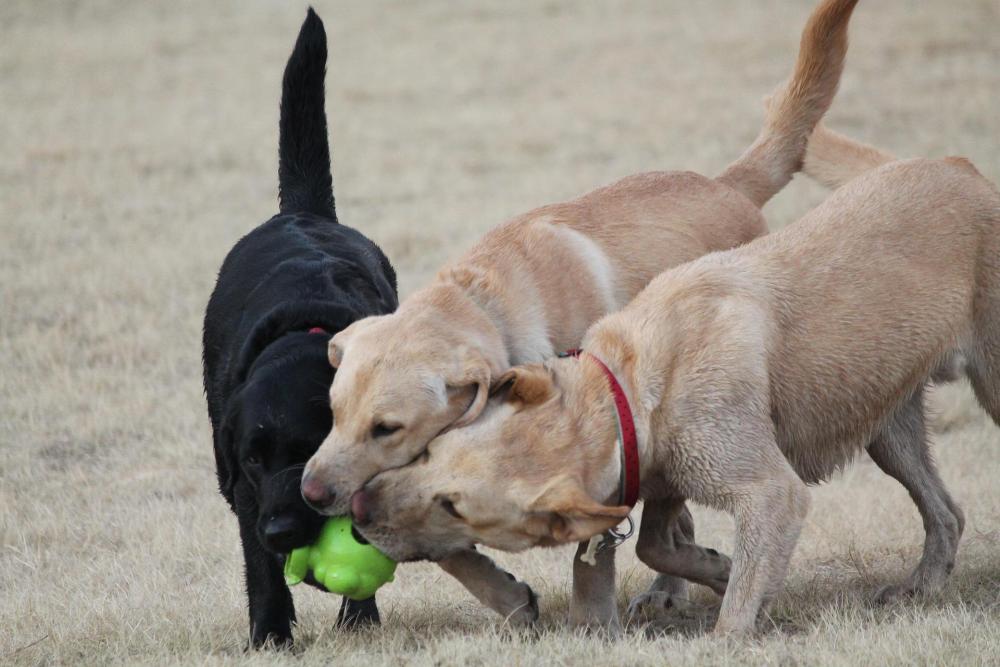
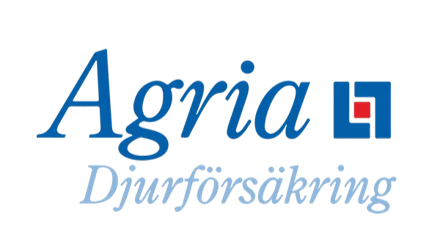
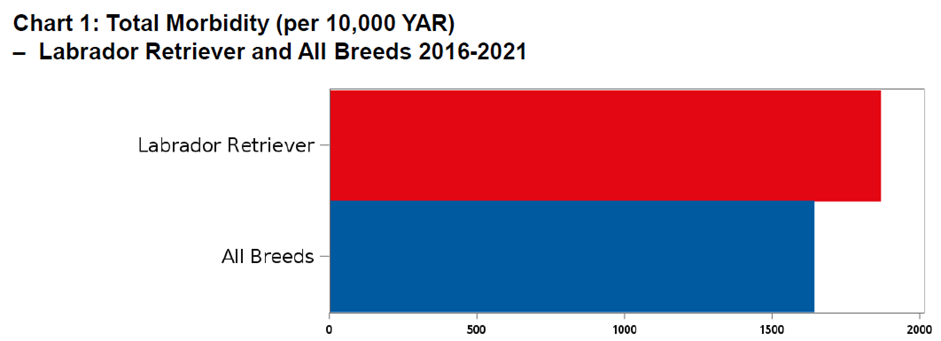
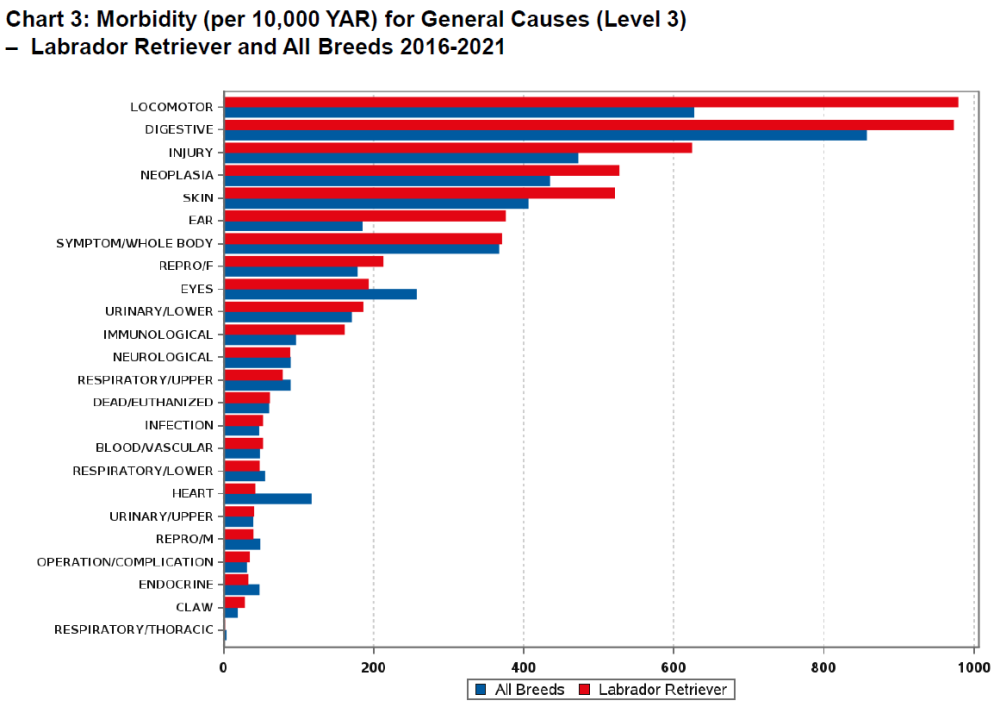
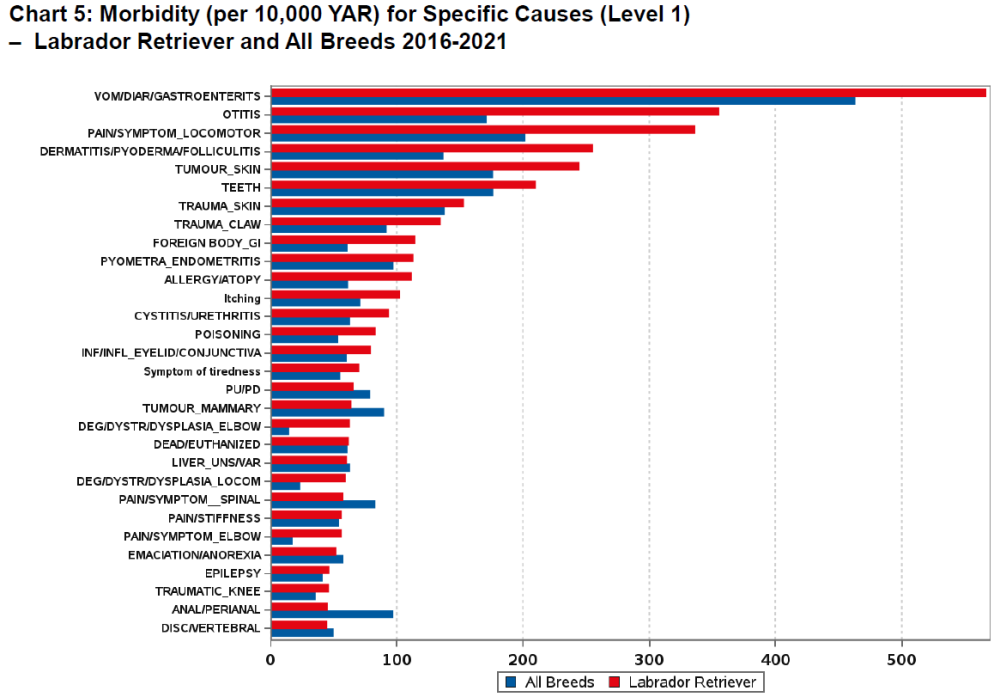
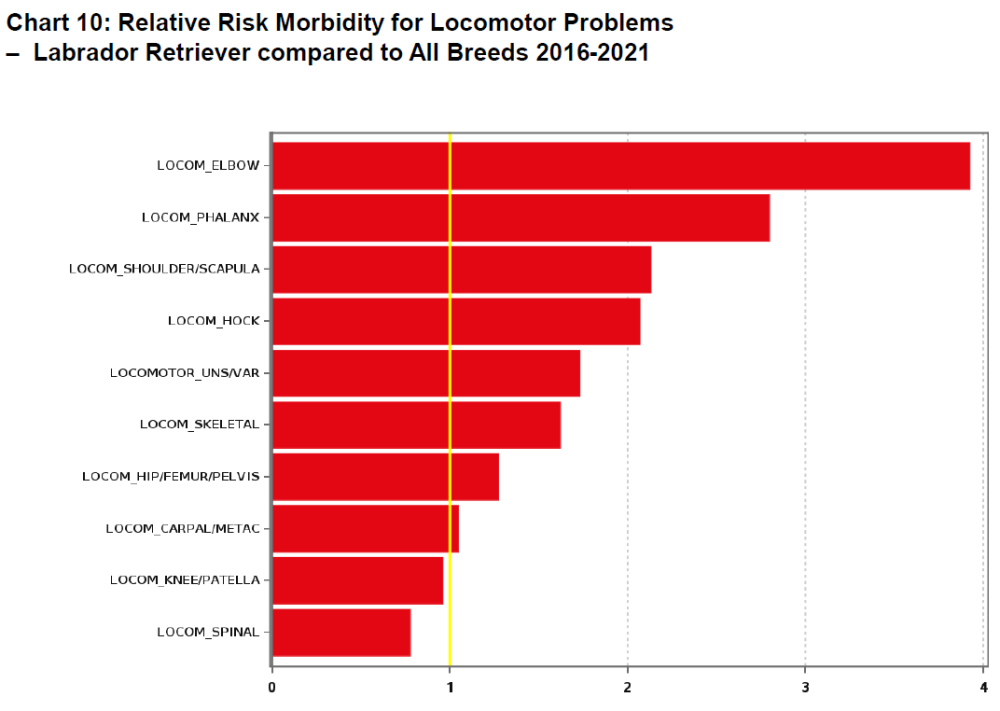
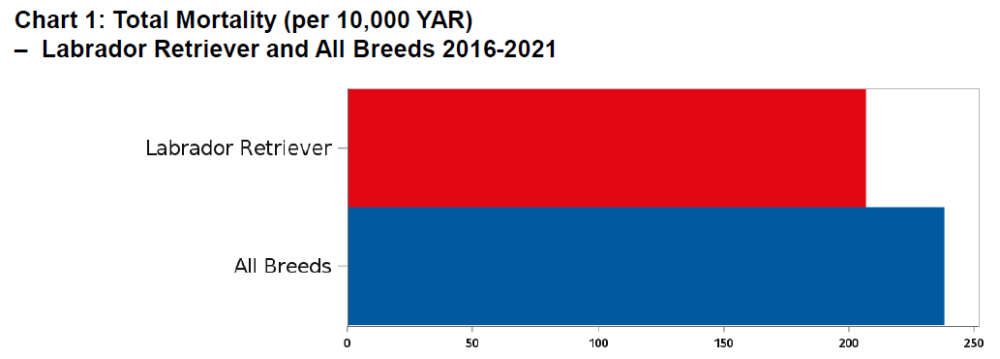
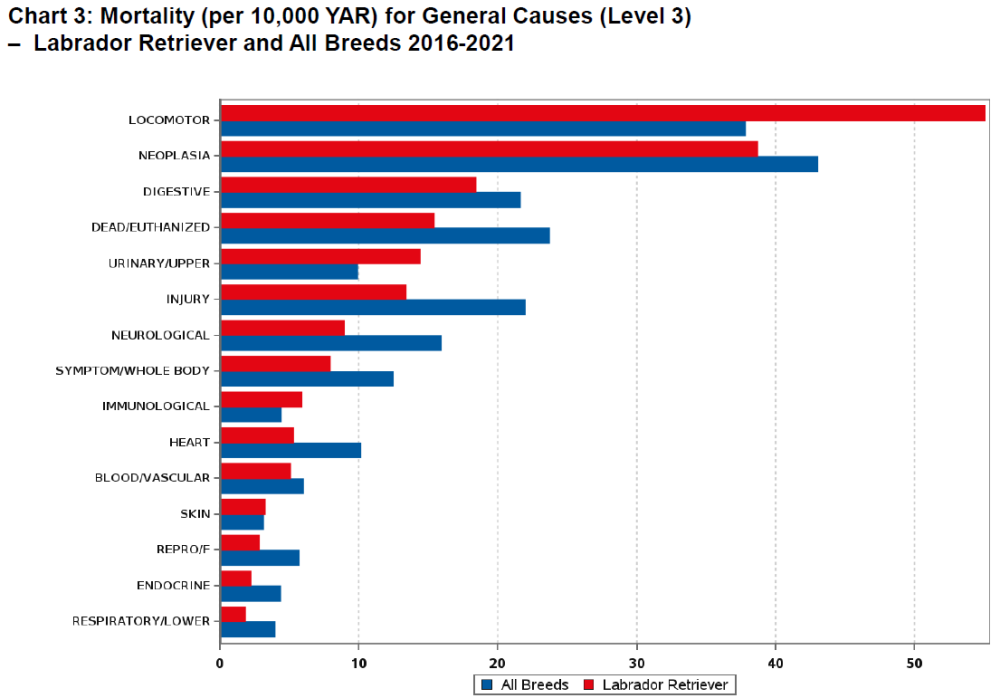
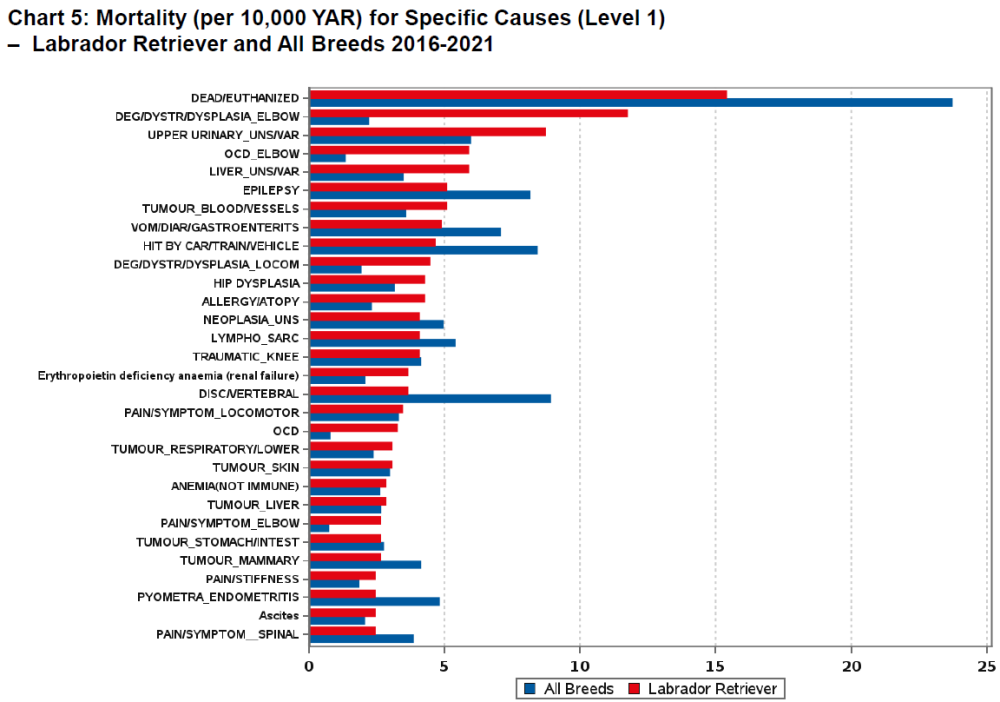





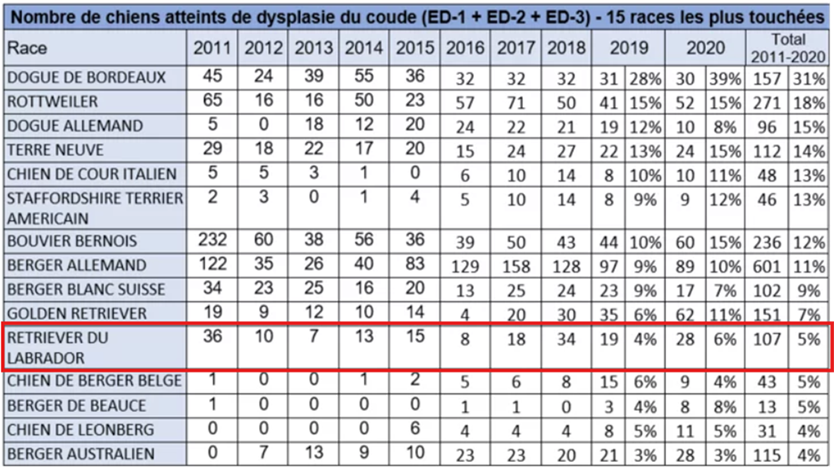
Recommended Comments
Join the conversation
You can post now and register later. If you have an account, sign in now to post with your account.
Note: Your post will require moderator approval before it will be visible.